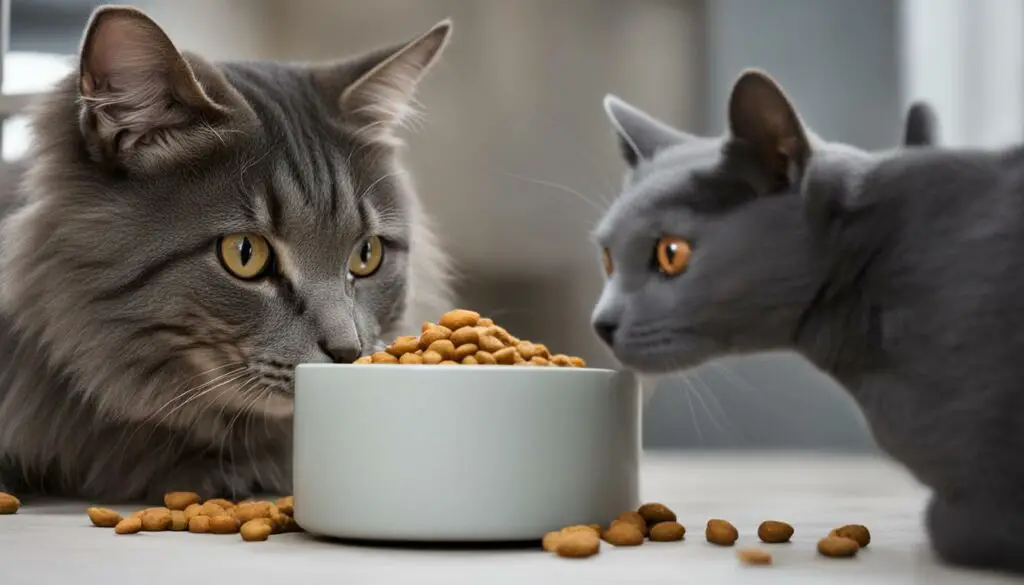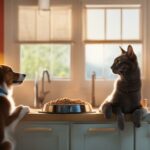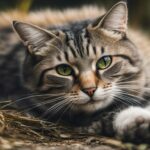Greetings! Today, I want to share some valuable insights on how to prevent your feline friend from gobbling up that tempting dog food. Cats may occasionally indulge in a doggy feast, but it’s important to understand the potential risks and take necessary precautions to keep them healthy. Let’s dive into the basics of stopping your cat from eating dog
food and ensure their nutritional needs are met.Key Takeaways:
- Limiting the cat’s access to dog food is crucial for their well-being.
- Cats may eat dog food due to curiosity or their natural inclination to snatch food, so prevention is key.
- Eating dog food can lead to various health issues for cats, including obesity and nutrient deficiencies.
- Creating a feeding routine and separating the cat and dog during meals can help prevent food theft.
- Automatic pet feeders can assist in providing individual meals and reducing the chance of the cat stealing dog food.
Why Cats Eat Dog Food: Understanding the Behavior
Cats are known for their curiosity and their tendency to steal food, and dog food is no exception. While it may seem harmless, it’s crucial to understand why cats eat dog food and the potential risks associated with this behavior. Dogs and cats have different nutritional needs, and consuming dog food can lead to health problems for cats.
One reason why cats eat dog food is out of curiosity. They may be intrigued by the different smell and taste of dog food and want to explore new flavors. Additionally, cats have a natural inclination to steal food, which can lead them to gravitate towards dog food bowls. However, it’s essential to prevent this behavior as dog food may not provide cats with the necessary nutrients they need to thrive.
Cats may eat dog food out of curiosity or because of their natural inclination to steal food.
Eating dog food can have detrimental effects on a cat’s health. Dog food lacks essential amino acids like taurine and arginine that cats require for proper functioning. These nutrients are crucial for maintaining a cat’s heart health, vision, and overall well-being. Furthermore, most dog food recipes contain cereal, which is not beneficial for cats to consume.
To ensure the health and well-being of your cat, it’s important to limit their access to dog food and provide them with a diet specifically formulated for feline nutritional needs. Consult with a veterinarian for advice on choosing the right cat food and preventing your cat from eating dog food.
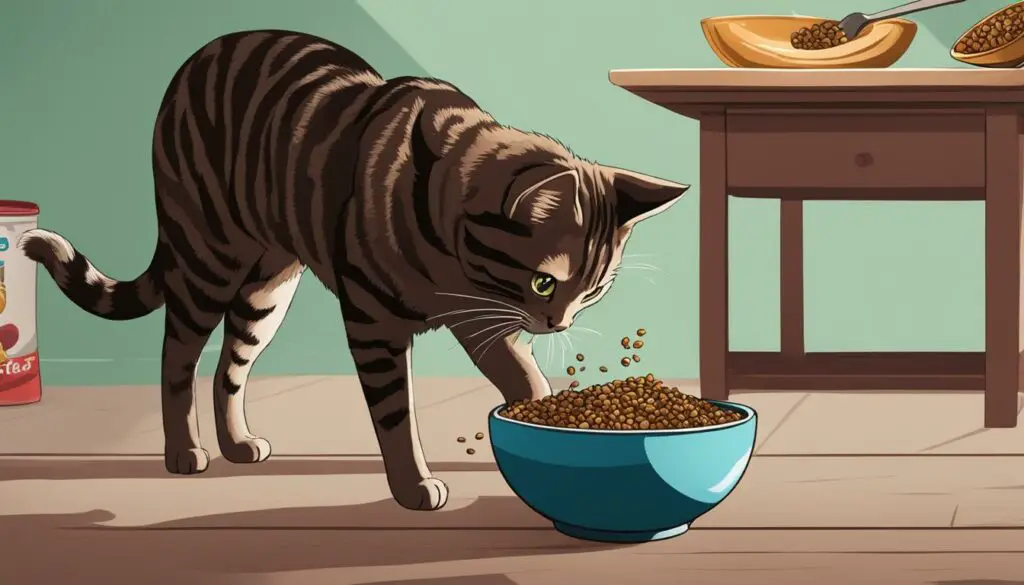
Table: Potential Health Risks of Cats Eating Dog Food
| Health Risks | Description |
|---|---|
| Obesity | Eating dog food, which is typically higher in calories than cat food, can contribute to weight gain and obesity in cats. |
| Nutrient Deficiencies | Dog food lacks essential amino acids, vitamins, and minerals that cats need for optimal health, leading to nutrient deficiencies. |
| Urinary Stones | Certain ingredients in dog food can increase the risk of urinary stones in cats, a painful condition affecting the urinary tract. |
| Heart Problems | The absence of specific nutrients in dog food can contribute to heart issues in cats, such as dilated cardiomyopathy. |
| Cancer | Inadequate nutrition from dog food can compromise a cat’s immune system and increase the risk of developing cancer. |
Preventing cats from eating dog food is essential for their overall health and well-being. Understanding the underlying behavior and the potential health risks associated with this habit can help cat owners take appropriate measures to ensure their feline friends receive a balanced and nutritious diet.
Health Risks of Cats Eating Dog Food
Eating dog food can pose serious health risks for cats. Cats have specific nutritional requirements that differ from dogs, and consuming dog food can lead to various health problems and complications. Here are some of the health risks associated with cats eating dog food:
Obesity
Cat food is formulated to meet the specific dietary needs of cats, while dog food is designed for dogs. Dog food tends to be higher in fat and calories, which can contribute to obesity in cats if consumed regularly. Obesity in cats can lead to other health issues such as diabetes, joint problems, and a reduced lifespan.
Malnutrition
Cats require certain essential nutrients, such as taurine and arginine, that are not adequately present in dog food. Taurine is an amino acid that is essential for cats’ heart health and vision, while arginine assists with the removal of waste products from their bodies. Insufficient levels of these nutrients can lead to serious health issues in cats.
Urinary Problems
Dog food typically contains higher levels of minerals, such as magnesium and phosphorus, which can increase the risk of urinary stones and crystals in cats. These urinary issues can be painful and may require medical intervention. Feeding cats a diet specifically formulated for their urinary health is crucial to prevent such problems.
| Health Risks | Effects |
|---|---|
| Obesity | Increased risk of diabetes, joint problems, reduced lifespan |
| Malnutrition | Deficiencies in essential nutrients like taurine and arginine |
| Urinary Problems | Risk of urinary stones and crystals, requiring medical intervention |
| Heart Problems | Insufficient taurine can lead to heart-related issues in cats |
| Cancer | No direct link, but poor nutrition can increase the risk |
It is important to prevent cats from eating dog food to ensure their overall health and well-being. Providing cats with a balanced diet specifically formulated for their nutritional needs is crucial for their long-term health. Consult with a veterinarian to determine the best diet and feeding routine for your cat, and ensure they are kept away from dog food to minimize health risks.
Limiting Access: The Key to Preventing Cats from Eating Dog Food
When it comes to preventing cats from eating dog food, the key is to limit their access to it. Cats are curious creatures and may be attracted to the smell or taste of dog food. However, it’s important to keep in mind that dogs and cats have different nutritional needs. Eating dog food can lead to health issues for cats, such as obesity and nutrient deficiencies. By controlling their access to dog food, you can ensure that they are getting the proper nutrition they need.
One effective way to limit access is to avoid free-feeding. Instead of leaving food out all day, establish specific meal times for both your cat and dog. This helps to create a routine and ensures that each pet receives their designated portion of food. Using automatic pet feeders can also be helpful in providing individual meals and preventing food theft. These feeders can be programmed to dispense food at specific times, reducing the risk of the cat stealing the dog’s food.
During mealtime, it’s important to separate the cat and dog to prevent any potential food stealing. This can be accomplished by feeding them in separate rooms or using barriers to create designated feeding areas. By doing so, you can ensure that the cat is focused on its own food, reducing the likelihood of it being interested in the dog’s food.
Table: Comparison of Feeding Methods for Cats and Dogs
| Feeding Method | Advantages | Disadvantages |
|---|---|---|
| Free-Feeding | – Convenient | – Difficult to control portion sizes – Increased risk of obesity |
| Scheduled Meals | – Portion control | – Requires a consistent routine – May cause anxiety if pets are used to free-feeding |
| Automatic Pet Feeders | – Individual meal portions – Programmable feeding times |
– Initial cost of feeder – Requires monitoring and maintenance |
By implementing these strategies and finding the right feeding routine for your cat and dog, you can effectively prevent cats from eating dog food. Remember to consult with your veterinarian for personalized advice and recommendations based on your pets’ specific needs. Ensuring that your pets are receiving the proper nutrition will contribute to their overall health and well-being.
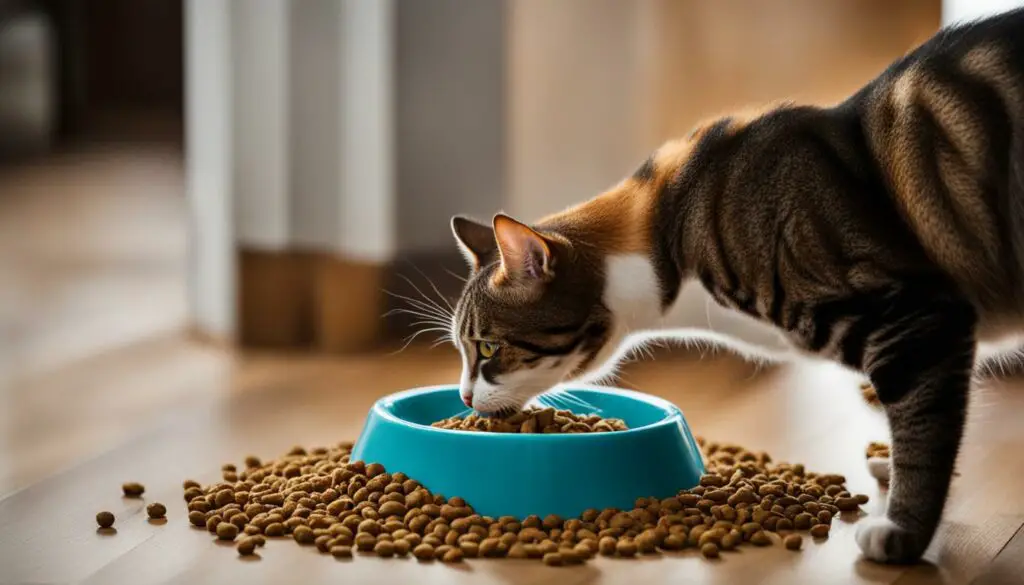
Feed Cat and Dog at the Same Time
Feeding the cat and dog at the same time can be an effective strategy to prevent the cat from stealing the dog’s food. By organizing their meals in separate rooms or using different areas for feeding, you can keep the cat busy with its own food and reduce its interest in the dog’s food. This method helps maintain the peace between the two pets and ensures that each one receives their proper nutrition.
When feeding the cat and dog at the same time, it’s important to establish a feeding routine that works for both pets. Set specific meal times and stick to them consistently. This helps regulate their eating habits and prevents the cat from raiding the dog’s bowl when it’s hungry. Additionally, monitoring each pet’s portion sizes and adjusting them according to their specific dietary needs is crucial.
Incorporating interactive feeders into mealtime can also be beneficial. These feeders require the cat to work for its food, keeping it engaged and focused on its own meal rather than the dog’s food. There are various interactive feeders available in the market, such as puzzle feeders or treat-dispensing toys, which can stimulate the cat’s natural hunting instincts and provide mental stimulation as well.
Benefits of Feeding Cat and Dog at the Same Time
- Reduced Food Competition: Feeding the cat and dog at the same time reduces the competition for food, ensuring that both pets get their proper nutrition without one stealing from the other.
- Established Routine: Following a consistent feeding routine helps regulate the pets’ eating habits and prevents the cat from becoming too hungry and resorting to stealing the dog’s food.
- Mental Stimulation: Using interactive feeders during mealtime provides mental stimulation for the cat, keeping it engaged and focused on its own food rather than the dog’s food.
By feeding the cat and dog at the same time, setting a feeding routine, and incorporating interactive feeders, you can prevent the cat from eating the dog’s food and ensure that both pets receive the nutrition they need for their overall health and well-being.
| Cat and Dog Feeding Tips | Benefits |
|---|---|
| Feed the cat and dog at the same time | Reduces food competition |
| Establish a feeding routine | Regulates eating habits |
| Use interactive feeders | Provides mental stimulation |
Use Automatic Pet Feeders
If you’re looking for a convenient and effective solution to prevent your cat from eating dog food, consider using automatic pet feeders. These innovative devices allow you to schedule individual meals for your cat and dog, ensuring they receive their food at the appropriate times. By setting specific feeding times, you can minimize the chances of the cat stealing the dog’s food.
Automatic pet feeders are particularly useful if you have a cat that tends to nibble on food throughout the day while your dog consumes their entire portion at once. With an automatic pet feeder, you can control the portions and feeding schedule for each pet, preventing the cat from accessing the dog’s food during meal times.
These feeders come in a variety of styles and sizes to accommodate the needs of different pets. Some models even have separate compartments or timers to dispense meals at different intervals. By investing in an automatic pet feeder, you can create a feeding routine that separates the cat and dog during mealtime, ensuring both pets receive the nutrition they need without the risk of food theft.
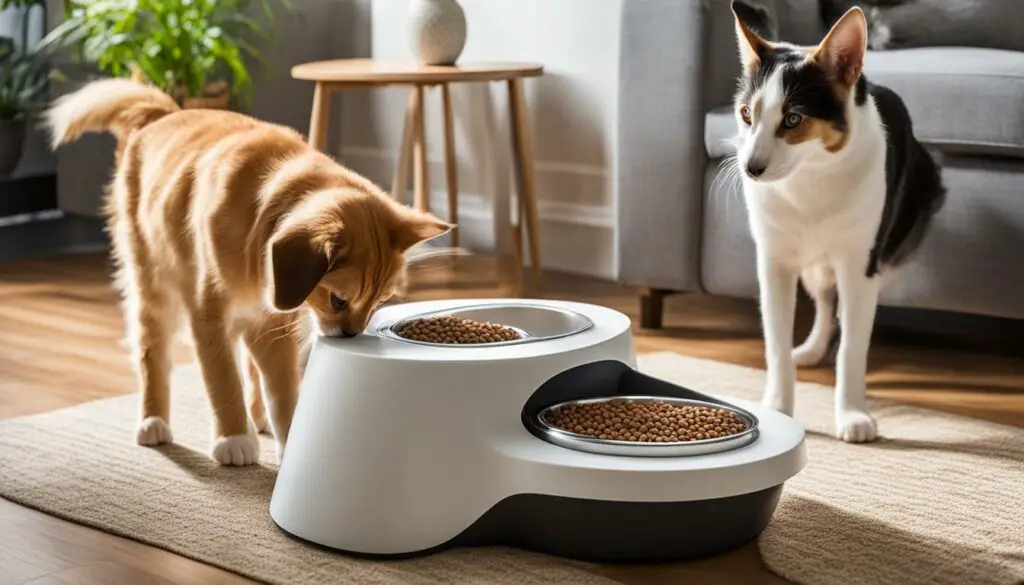
The Benefits of Using Automatic Pet Feeders:
- Allows you to schedule individual meals for your cat and dog
- Prevents the cat from stealing the dog’s food
- Controls the portions and feeding schedule for each pet
- Creates a feeding routine that separates the cat and dog during mealtime
- Reduces the risk of food theft and promotes healthier eating habits
Ensure Your Cat Loves Its Food
If you want to prevent your cat from seeking out dog food, it’s crucial to make sure that your cat is satisfied with its own food. Choosing the right cat food that is rich in essential vitamins and minerals is key to keeping your cat happy and healthy. Consult with a veterinarian to determine the best diet for your cat and consider different food options if your cat shows disinterest in its current diet.
You can try offering a variety of flavors and textures to entice your cat. Some cats prefer wet food, while others may prefer dry kibble. Experimenting with different options can help you find the food that your cat truly enjoys. Additionally, consider feeding your cat smaller, frequent meals rather than one large meal to keep them engaged and interested in their food.
Remember, a cat’s sense of taste is different from ours, so what may seem unappetizing to you could be a favorite for your cat. Pay attention to their preferences and provide them with a high-quality, nutritious meal. When your cat is satisfied with its own food, the likelihood of it seeking out dog food diminishes.
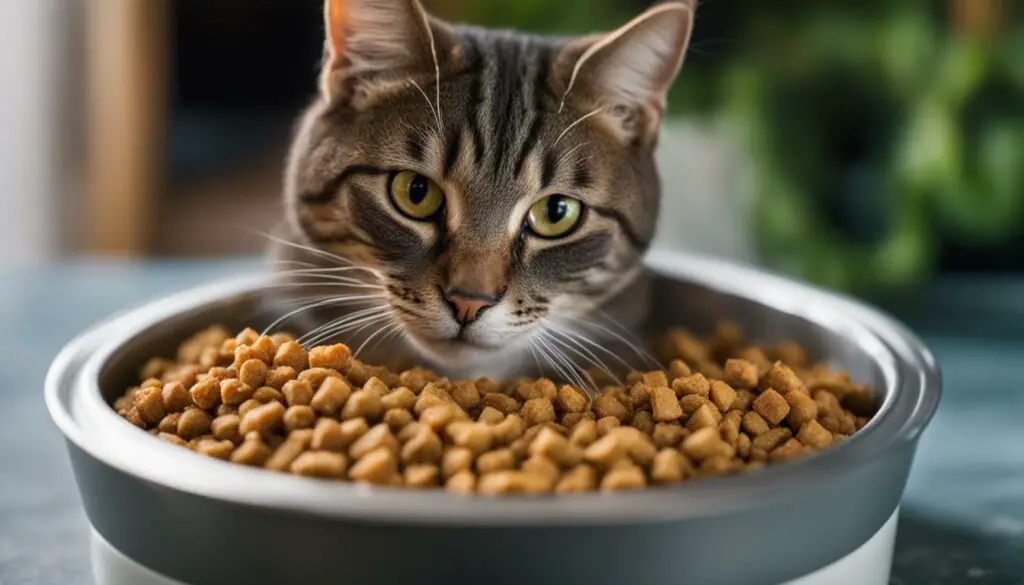
Benefits of Ensuring Your Cat Loves Its Food
When your cat loves its food, it not only helps prevent them from eating dog food but also has other benefits for their overall health and happiness. Here are a few reasons why ensuring your cat loves its food is important:
- Cats that enjoy their food are more likely to maintain a healthy weight, reducing the risk of obesity-related health issues.
- A cat that loves its food will be more enthusiastic about mealtime and have a better appetite, ensuring they get the necessary nutrients they need.
- Choosing a cat food that meets their nutritional needs can help support their immune system, digestion, and overall well-being.
By prioritizing your cat’s food preferences and providing them with a nutritious diet, you can help prevent them from seeking out dog food and ensure they thrive.
Addressing Hunger in Cats
When it comes to cats stealing dog food, one of the underlying causes may be hunger. It’s essential to address your cat’s dietary needs to prevent this behavior. Ensure that your cat is receiving enough food and that its diet is appropriate for its age and health condition. If your cat is on a restricted diet for weight loss or health reasons, it may take some time for it to adjust to the new portions.
To monitor your cat’s weight effectively, it’s crucial to consult with a veterinarian for guidance. They can provide personalized feeding recommendations based on your cat’s specific requirements. It’s important to note that sudden changes in diet or portion size can be stressful for cats, so gradual transitions are often recommended.
Providing your cat with adequate nourishment will help address any hunger issues and reduce the likelihood of it seeking out dog food. It’s also important to monitor your cat’s weight regularly and make adjustments as needed to maintain a healthy balance.
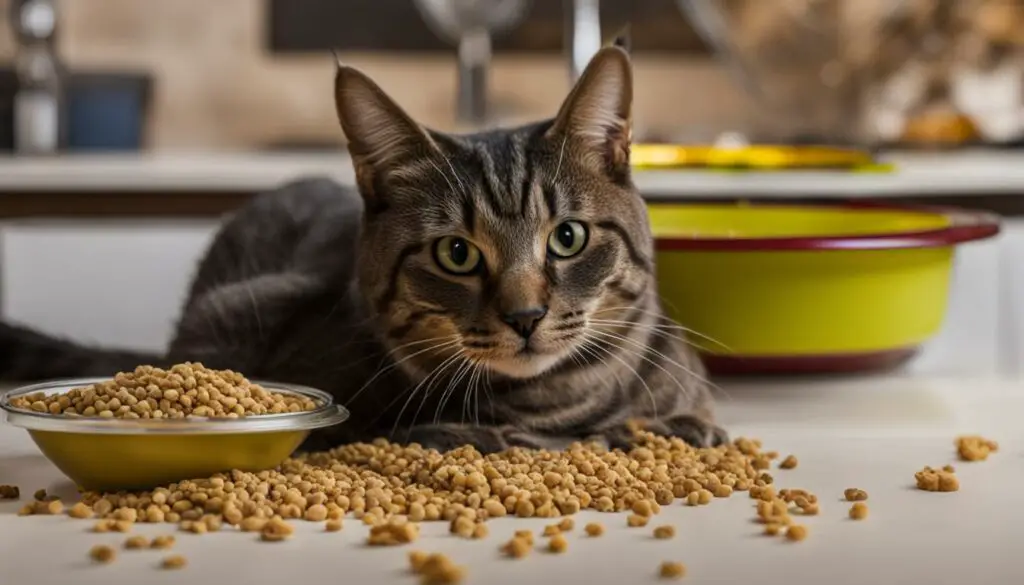
“Addressing your cat’s hunger and ensuring a proper diet is crucial in preventing them from seeking out dog food.”
Getting Tricky to Prevent Food Theft
Preventing cats from stealing dog food requires some creative strategies. Here are a few tricks you can try to keep your cat away from your dog’s food:
Elevated Platform
Place your dog’s food bowl on an elevated platform that is out of reach for your cat. Cats are excellent climbers, but by raising the food bowl higher, you can discourage your cat from attempting to steal the food. This not only keeps your cat away from the dog’s food but also adds an extra element of challenge that may reduce their interest in trying.
Secure Containers
Store your dog’s food in containers with lids that can be tightly sealed. This will prevent your cat from being able to access the food even if they manage to reach the container. Make sure to choose containers that are sturdy and secure, keeping the food fresh while also keeping your cat at bay.
Indoor Dog Fences
Consider using indoor dog fences to create a physical barrier between your cat and your dog’s feeding area. These fences are designed to keep dogs in designated spaces, but they can also be effective in keeping cats out. By confining the dog to a specific area during mealtimes, you can ensure that the cat cannot approach the food without being stopped by the fence.
| Elevated Platform | Secure Containers | Indoor Dog Fences | |
|---|---|---|---|
| Effectiveness | Medium | High | High |
| Difficulty | Low | Low | Medium |
| Cost | Low | Low | Medium |
| Additional Benefits | Can discourage climbing | Keeps food fresh | Creates a designated dog space |
By implementing these strategies, you can make it more difficult for your cat to steal your dog’s food. Experiment with different methods and find what works best for your household. Remember, it’s essential to prioritize your pets’ individual nutritional needs and ensure they each have their own designated feeding areas.

Conclusion
In conclusion, preventing cats from eating dog food is crucial for their overall health and well-being. Cats and dogs have different nutritional needs, and consuming dog food can lead to various health problems for cats, such as obesity and nutrient deficiencies.
To stop your cat from eating dog food, it is important to limit their access to it. Avoid free-feeding and establish a feeding routine that separates the cat and dog during mealtime. Using automatic pet feeders can also be helpful in providing individual meals and preventing food theft.
Additionally, ensuring that your cat loves its own food is essential. Choose cat food that is rich in essential vitamins and minerals, and consult with a veterinarian for personalized feeding recommendations. If your cat is stealing dog food out of hunger, address its dietary needs and monitor its weight accordingly.
Innovative solutions such as placing the dog’s bowl on an elevated platform or using containers with lids can also help prevent food theft. By implementing these strategies and prioritizing your cat’s specific needs, you can successfully stop your cat from eating dog food and ensure its overall health and well-being.
FAQ
Can cats eat dog food?
Cats can eat dog food, but it is not recommended. Dogs and cats have different nutritional needs, and dog food may not provide cats with the necessary nutrients they need.
What health problems can arise from cats eating dog food?
Cats eating dog food can lead to health problems such as obesity, diabetes, osteoarthritis, heart problems, urinary stones, and cancer. Dog food lacks essential amino acids, taurine, and arginine that cats need.
How can I prevent my cat from eating dog food?
The best way to prevent cats from eating dog food is to control their access to it. Avoid free-feeding and feed the cat and dog at specific times. Using automatic pet feeders can also help in providing individual meals and preventing food theft.
Should I feed my cat and dog at the same time?
Feeding the cat and dog at the same time can help prevent the cat from stealing dog food. You can organize their meals in separate rooms or use different areas for feeding. By keeping the cat busy with its own food, it reduces the likelihood of it being interested in the dog’s food.
How can automatic pet feeders help prevent cats from eating dog food?
Automatic pet feeders can be useful in preventing cats from eating dog food. By scheduling individual meals for each pet, you can ensure they receive their food at the appropriate times. This helps minimize the chance of the cat stealing the dog’s food.
What should I do if my cat doesn’t like its own food?
If your cat shows disinterest in its current diet, consult with a veterinarian to determine the best food options. Choose cat food that is rich in essential vitamins and minerals to ensure your cat is satisfied with its own food.
What should I do if my cat is hungry and stealing dog food?
Make sure your cat is receiving enough food and that its diet is appropriate for its age and health condition. If your cat is on a restricted diet, it may take time for it to adjust to the new portions. Monitor your cat’s weight and consult with a veterinarian for guidance.
How can I prevent my cat from stealing dog food?
Try placing the dog’s bowl on an elevated platform where the cat can’t reach. Store the dog food in containers with lids or use indoor dog fences to keep the cat away from the food. Finding inventive solutions can help keep the cat and dog meals separate.

